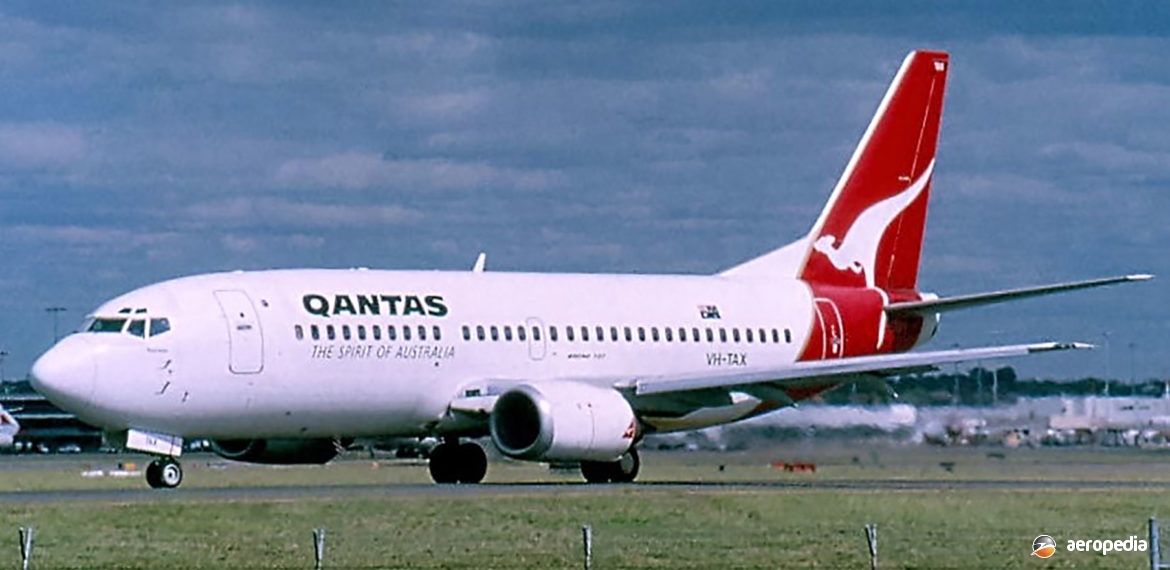Photograph:
Boeing 737-476 VH-TAX (c/n 23489-1356) at Mascot, NSW in December 2004 (David C Eyre)
Country of origin:
United States of America
Description:
Short-haul commercial airliner
Power Plant:
Two 22,000 lbst CFM563B-2 turbofans
Specifications:
- Wingspan: 28.88 m (94 ft 9 in)
- Length: 36.45 m (119 ft 7 in)
- Height: 11.13 m (36 ft 6 in)
- Wing area: 105.4 m² (1,135 sq ft)
- Max cruising speed at 10,670 m (35,000 ft): 845 km/h (525 mph)
- Economical cruising speed at 9,150 m (30,000 ft): 813 km/h (505 mph)
- Max operating altitude: 11,278 m (37,000 ft)
- Range with max payload (146 passengers): 4,003 km (2,487 miles)
- Fuel capacity: 20,105 litres (4,422 Imp gals)
- Take-off field length required: 2,316 m (7,600 ft)
- Empty weight: 33,340 kg (73,490 lb)
- Max payload: 18,280 kg (40,300 lb)
- Loaded weight: 62,822 kg (138,500 lb)
History:
Next variant in the Boeing 737 series was the Model 737-400, which typically had a flight crew of two and seating for 146. This was developed as a Model 727 replacement and major changes over the smaller 737-300 series was a 3.05 m (10 ft) lengthening of the fuselage, more powerful 23,500 lbst CFM56-3C-1 engines, increased weights and other changes.
Boeing announced in June 1986 it was developing a new higher capacity variant of the Model 737-300 which was aimed at the market for 150 seat airliners. The fuselage was stretched by 3.05-m (10 ft) in total, comprising 1.83 m (6 ft) forward of the wing and 1.22 m (4 ft) aft of the wing. This stretch in fact meant the aircraft had a maximum capacity of up to 188 passengers and, to cope with this, new variants of the CFM56 turbofan were developed and installed. A higher gross-weight variant was offered, this having increased fuel capacity, a strengthened undercarriage and other strengthening.
The first Model 737-400 flew on 19 February 1988 and first deliveries to Piedmont Airlines took place in October that year. Because it was able to fly non-stop across the United States, this model became very popular with American operators.
The Model 737-400 series proved to be popular in this region, with aircraft ordered by Qantas, although it faced competition from the 20 Airbus A320s operated by Ansett Airlinesx. However, following the demise of the latter, its A320s were exported, Qantas replaced the first generation Boeing 737s with later models, and set up Jetstar which put into service the Boeing 737’s competitor, the Airbus A320. Accommodation was provided for a flight crew of two and 159 passengers in one class, or 146 in two-class seating, but up to 168 could be carried at 76 cm (30 in) seating pitch.
The series continued to be developed. The Model 737-500 was the shortest and smallest aircraft in the series and had a seating capacity of 108, with eight in first class and 100 in economy. This model had the 20,000 lbst CFM56-3C-1 engine but length was reduced to 31.01 m (101 ft 9 in). First aircraft of this model flew on 30 June 1989 and it entered service in February 1990. More than 390 Series 500s were built.
In late 2007 Qantas still operated 18 Model 737-476s but as the new Series 800 aircraft came on line these were sold. Qantas Model 737-476s were in service from early 1990 and these aircraft include: VH-TJE (c/n 24430), VH-TJF (c/n 24431), VH-TJG (c/n 24432), VH-TJH (c/n 24433), VH-TJI (c/n 24434), VH-TJJ (c/n 24435), VH-TJK (c/n 24436), VH-TJL (c/n 24437), VH-TJM (c/n 24438), VH-TJO (c/n 24440), VH-TJR (c/n 24443), VH-TJS (c/n 24444), VH-TJT (c/n 24445), VH-TJU (c/n 24446), VH-TJX (c/n 28150), VH-TJY (c/n 28151) and VH-TJZ (c/n 28152).
In 1999 a new Tasman airline commenced services, this being K2000, its inaugural service being from Brisbane, QLD to Hamilton, NZ, the aircraft used being a Model 737-4Q8/SF TC-AFA (c/n 2653) leased from Turkish based Pegasus Airlines. Services were also operated from Auckland and Dunedin to Sydney but the airline only survived for a short time.

